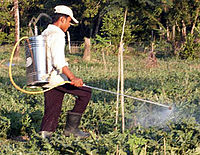
Photo from wikipedia
Soil arthropods, including soil insects and mites, play a significant role in the recycling of fertility material and maintenance of soil structure. This study was performed to determine the non-target… Click to show full abstract
Soil arthropods, including soil insects and mites, play a significant role in the recycling of fertility material and maintenance of soil structure. This study was performed to determine the non-target effects of two different formulations of fipronil on four groups of soil-dwelling insects (collembola, earwig, staphylinids and ants) and one group of mites. The pitfall traps were installed to estimate the arthropod population. The population per trap was evaluated after 3, 6, 9 12, 15, 18 and 21 days after insecticides’ application. The population of soil-dwelling arthropods was significantly reduced in the case of fipronil 5% SC (soluble concentration) treated plots after 3 and 6 days of application. However, the fipronil 0.3 GR (granule) was more toxic at 9th and 12th day of application. The toxicity of fipronil was decreased with the passage of time but fipronil 0.3 GR remained toxic until 18 days in some cases. Hence, both formulations of fipronil reduced the population of non-target soil arthropods, but fipronil 5% SC was more toxic than fipronil 0.3 GR when compared with the untreated check (control plot). According to these results, the application of fipronil should be reduced and find an alternative way instead of this pesticide.
Journal Title: International Journal of Tropical Insect Science
Year Published: 2020
Link to full text (if available)
Share on Social Media: Sign Up to like & get
recommendations!